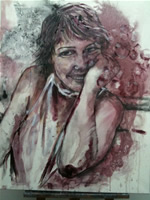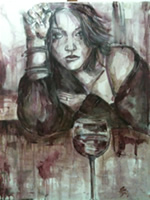
Posted: Friday, 24 February 2023 08:41
From Archives (2011)- Anteprima Montepulciano 2011: Wine and Art
 Wine and art have been linked together in more than one way. Wine has been the subject of many artists who are often commissioned to paint for labels that are reproduced on the bottle. Mouton Rothschild has been a pioneer in Bordeaux while Grover, Sula, Opera, Chateau d’Ori are a few such examples of emulating in India-. There is a French artist Jean- Pierre Got who has become famous for making special posters for wine events and wineries across the globe.
Wine and art have been linked together in more than one way. Wine has been the subject of many artists who are often commissioned to paint for labels that are reproduced on the bottle. Mouton Rothschild has been a pioneer in Bordeaux while Grover, Sula, Opera, Chateau d’Ori are a few such examples of emulating in India-. There is a French artist Jean- Pierre Got who has become famous for making special posters for wine events and wineries across the globe.
Wine also helps boost one’s faculties for art appreciation. At an event organised by the Indian Wine Academy at Polka Art Gallery in Defence Colony, Delhi a couple of years ago, the Chief Guest Mr Ashok Vajpai, Chairman of Lalit Kala Academy gave an interesting perspective on the importance of wine in appreciating art. Looking at a painting, his perspective would change after a glass of wine, he said. He could sense a deeper meaning after gazing after two glasses. We did not quiz him on what happened with more than two glasses under the gullet but his perception makes enough sense for art galleries to generally serve wine at the opening of new shows and exhibitions.
Eno-art or use of wine as paint medium

The paintings were generally in wine colours with a spread of grey and other lighter shades making them very pleasant. A gentleman stood close-by with several copies of a hard-cover, ‘Elisabetta Rogai- Anatomie dell’ anima on the table.’ The book cover featured the back of a nude woman sleeping peacefully. He explained that all the paintings on the walls, about 5-6 of them, were created by a well known Tuscan pittrice (female painter) Elisabetta Rogai from Florence. She had been commissioned by the Consorzio, known for their ingenuity in adding something unique every year to the professional tasting; last year saw cosmetics made exclusively from the red grape must of Montepulciano after the fermentation.
Fortunately, the painter was at hand and was pleased to explain to me about her work and the ‘eno-art’ she had created. ‘It took a long period of research and experimental work, involving the University of Florence before I could develop the wine-made paintings,’ she said Most comfortable with oil and canvas and blue denim, she had used only a bit of charcoal for the main lines of this style of paintings. She uses only white and red wine with no additives or chemical components. ‘Such combination allows the wine to reproduce on the canvas exactly the same process of ageing that normally takes place inside the bottle,’ she says.

A curator of one of her several shows in Italy and Japan, sums up her work. ‘Elisabetta’s paintings will not leave you indifferent, her colours and forms will penetrate your soul. Her portraits, mostly of beautiful women tell their story which goes beyond serotypes. The first glance could mesmerize anyone who loves his glass of Vino Nobile di Montepulciano or Rosso di Montepulciano.
This is not the first time Rogai has worked with wine as the protagonist. Another event abroad that made her famous was the label she created for the Chianti Classico Astrid, the official wine chosen for the semester of the Italian presidency for the European Union Council.
Elisabetta delivers a bottle of red wine to the university and gets back the residue after due processing-it is more like gooey paste, she says. She also uses boiled wine for a part of the paintings. The result is impressive- the new painting changes its texture three months later and the difference is visible. The colours evolve on the canvas from typically young purples and cherry reds to more mature tones of orange, amber or brown. ‘The wine aging which normally occurs over the years, takes only a few months on the canvas,’ she says with a smile.

After Montepulciano the works move to other parts of Italy before ending up in Vinitaly from April 7-11, where they may be viewed at the Balzini stand.
One has heard of enoteca, eno-tourism, enologo in the Italian wine segment: eno-art may be the new term the wine connoisseurs will soon love to know of.
Subhash Arora
February 21, 2011

